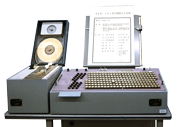
- Home >
- Historical Computers in Japan >
- Printers >
- SC-4 and SCK-201 kanji-character teleprinters
【Shinko MechatroTech】 SC-4 and SCK-201 kanji-character teleprinters
Shinko MechatroTech developed a kanji-character teleprinter in 1955 together with the Asahi Shimbun Company, a newspaper company in Japan. This development resulted in Shinko MechatroTech coming out in 1958 with Japan’s first commercial kanji teleprinter consisting of the SC-4 kanji keyboard and tape-punch unit and the SC-4 kanji print translator (printer). The SCK-201 kanji-character keyboard and tape-punch unit was a lightweight, portable machine developed in 1968.
Prior to 1954 Japan’s telecommunications made use of kana-character printing telegraphy, which mainly used kana characters. But since the Japanese language has many homonyms, the kana-to-kanji translation process was riddled with errors. The newspaper industry, which relied on carrier pigeons to send manuscripts at the time, had strong hopes for the implementation of mixed kanji-kana printing telegraphy for accurate communications. This prompted many companies to research kanji teleprinters and kanji teletypes to send and print telegraphs with Japanese characters.
Given this context, the commercial kanji teleprinter SC-4 keyboard and tape-punch unit and SC-4 kanji print translator (printer) made a huge contribution in speeding up telecommunications for news organizations and mechanizing newspaper page layouts. The units also made it possible to automatically compose print type from received telecommunications data. Newspaper companies battled to be the first to install these kanji teleprinters, leading to their adoption throughout the newspaper industry.
Shinko MechatroTech’s kanji teleprinters were used in NTT and KDD(currently KDDI Corporation) systems at the Tokyo Olympics in 1964, and the company’s portable SCK-100 kanji keyboard, developed in 1967, was used to report on the Mexico Olympics and the Apollo moon landing. Based on these successes, Shinko MechatroTech developed the small, lightweight portable SCK-201 kanji keyboard and tape-punch unit in 1968. And around 1975, the company developed the microcomputer-controlled SCK200F kanji input unit.
Kanji teleprinters were the first devices to implement kanji input and output functions with the multistage keyboard shift system (multistage shift system). As such, they played a crucial role in the day as Japanese language I/O devices. They were widely used by news organizations, government offices, the printing industry, life insurers, and others. Kanji teleprinters sustained Japanese language culture, as far as telecommunication equipment goes, for about 30 years until the word processor arrived. The kanji teleprinter can be considered the antecedent of today’s Japanese-language word processors.
The multistage shift system used on the SCK-201 kanji keyboard and tape-punch unit assigned 12 characters (three columns by four rows) to each keyboard key. With a layout of 192 keys (24 columns x 8 rows) in total, the unit could handle 2,304 different characters. Operators would select one of the 192 character group keys with the right hand and select the character position within the key with the left hand. Telegrams inputted with a mix of kanji and kana characters were encoded in a 6 x 2 array and sent to the other party via punched tape. The kanji print translator (printer) on the receiving side would then print out the kanji characters.
 | ||
| SCK-201 kanji keyboard and tape-punch unit |
